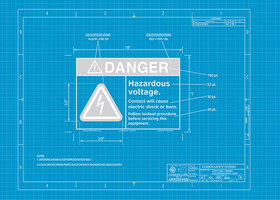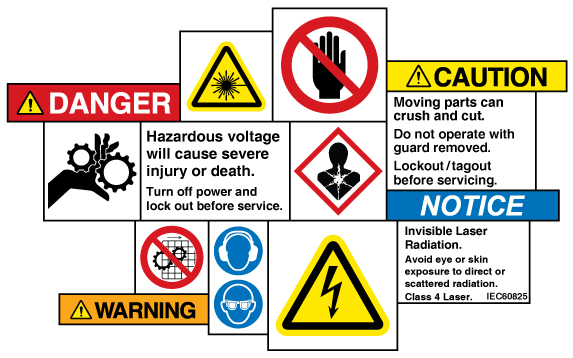Four Questions to Ask When Designing Product Safety Labels
Posted by Geoffrey Peckham | 22nd Aug 2016

We recently posted a piece here on the Clarion blog on key considerations for designing safety signs for workplaces. Now I’d like to do the same thing for product safety labels. Here are four questions I consider central to designing product safety labels:
- Question #1
Before you begin the design of a product safety label, ask yourself, is this label part of a “system” of labels that go on this one product model (or a series of product models), or will it be used on your company’s entire product line? The point here is that rarely does a product safety label exist all by itself; its creation usually needs to take into account all of the other labels you use so they can work together to communicate risk and promote safe work behaviors. And they need to do this in a uniform way. Which leads to the next question…
- Question #2
Which of the latest best practice standards are you going to use for this label’s design? ANSI or ISO? This is sort of a trick question because over the years, these standards have incorporated design principles that are harmonized, meaning if you choose to use them, you’ll be in compliance with both standards. But there are a lot of nuances to this question and to the standards. Getting things “right” for your product in terms of your format choice (and the content that goes into that format) may very well be a different “right” than another company would choose for their products.
How two things can be different and both be “right” (or wrong) is something that, I believe, only comes from having experience in applying these standards to a wide range of applications. Symbol-only, symbol-with-words, multiple-symbols-with-words, added translation panels, which signal word is most appropriate….these are the sorts of choices that need to be addressed to meet the specific situation. Rarely is there one right choice, but there are better choices than others.

- Question #3
Who is your intended audience? Answering this question gives you the ability to intelligently design your product safety labels to meet the needs and characteristics of the people you’re trying to protect from harm – and that’s the goal. Too often design engineers write things to their higher level of learning. They understand the potential risks associated with their product, risk assessment methodologies, and how risk can be lessened or avoided. But the objective of a product safety label system is to communicate these things at the lowest anticipated level of understanding that occurs in your anticipated product user population – the people that you foresee will need to see the product safety label and obey its message. In my experience, you find yourself writing most labeling to meet the reading level of an 8th grade education. Keeping things simple and direct is usually the best approach.
- Question #4
Finally, though there are a dozen other questions that come to mind, this one stands out because it ties into the three prior questions: do one or more safety symbols exist that will help to communicate your product safety label’s intended message? I’m not talking, here, about the ad hoc safety symbols you’ll find offered up on the signs and labels from the vast majority of safety sign companies. Steer clear of that visual mess. I’m talking about safety symbols that have either been officially registered by ISO as the definitive symbol for a given meaning, or safety symbols that are created using the design criteria established by ISO standards.

You could certainly say here that I’m promoting something that I had a significant hand in writing, since I’ve chaired the U.S. committee (TAG) for ANSI to the ISO standards in this field for the past twenty years. And that’s fine, because at the end of the day the fact remains that these ISO standards are accepted by ANSI, sold by ANSI and define for the world current best practices in, what I call, visual risk communication. And that is what you want to use in your quest to best protect people from harm and meet your legal “duty to warn,” both here in the U.S. and abroad.
Geoffrey Peckham
CEO, Clarion Safety Systems

This blog is part of a series of regular posts from our CEO, Geoffrey Peckham, to share his insight. Geoffrey serves as chair of the ANSI Z535 Committee for Safety Signs and Colors and chair of the U.S. TAG to ISO/TC 145 – Graphical Symbols. He has also been selected as a member of the U.S. TAG to ISO/PC 283, an ISO committee writing a new standard, ISO 45001 Occupational Health and Safety Management Systems, which will, when finished, define global best practices for workplace safety. In addition, he is an active member of many industry-specific standards committees related to safety signs and labels for buildings, ships, machinery and products.